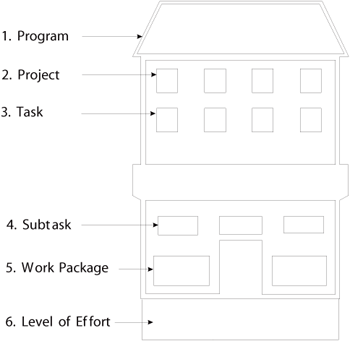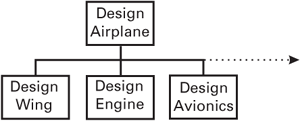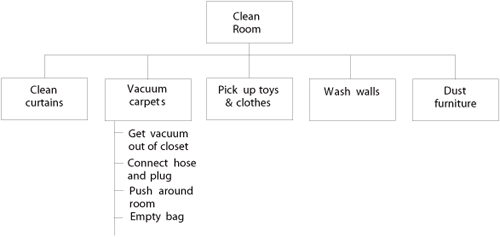A Simple Example
As an example, if I want to clean a room (see Figure 5-1), I might begin by picking up clothes, toys, and other things that have been dropped on the floor. I could use a vacuum cleaner to get dirt out of the carpet. I might wash the windows and wipe down the walls, then dust the furniture. All of these activities are subtasks performed to clean the room.
As for vacuuming the room, I might have to get the vacuum cleaner out of the closet, connect the hose, plug it in, push the vacuum cleaner around the room, empty the bag, and put the machine back in the closet. These are still smaller tasks to be performed in accomplishing the subtask called vacuuming. The diagram in Figure 5-1 shows how this might be portrayed in WBS format.
Note that we do not worry about the sequence in which work is performed when we do a WBS. That will be worked out when we develop a schedule. However, you will probably find yourself thinking sequentially, as it seems to be human nature to do so. The main idea of doing a WBS is to capture all of the tasks. So if you find yourself and other members of your team thinking sequentially, don’t be too concerned, but don’t get hung up on trying to diagram the sequence or you will slow down the process of task identification.
A Work Breakdown Structure does not show the sequence in which work is performed! Such sequencing is determined when a schedule is developed.
The typical WBS has three to six levels, and these can be named as shown in Figure 5-2. It is, of course, possible to have projects that require a lot more levels. Twenty levels is considered to be the upper limit, and that is a huge project. Note that level 1 is called the program level. The difference between a program and a project is just one of degree.
Figure 5-2. WBS level names.

An example of a program is the development of an airplane. For example, the WBS for Boeing’s 777 airplane program might have been drawn as shown in Figure 5-3. Notice that the engine, wing, and avionics are large enough jobs to be called projects in their own right. In fact, the program manager’s job is to make sure that the projects are all properly integrated. The engine mounts on the wing, so, somewhere in the structure to develop the engine, there will be an activity called “Design wing mounts.” And for the wing, there will be an activity called “Design engine mounts.” If these are not coordinated properly, you will wind up with an engine that won’t mount on the wing. The job of coordinating these is called system integration.
Figure 5-3. Partial WBS for the 777 development program.


